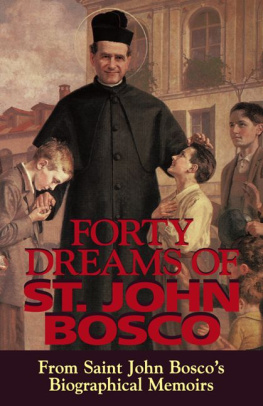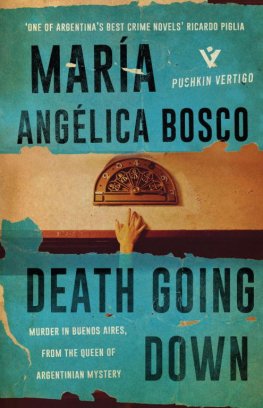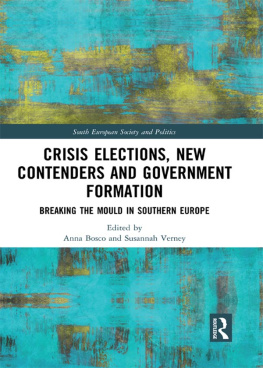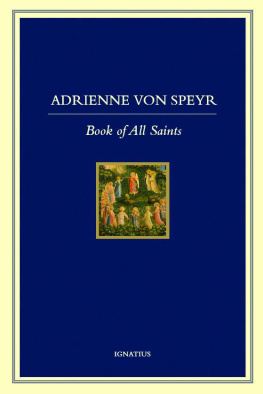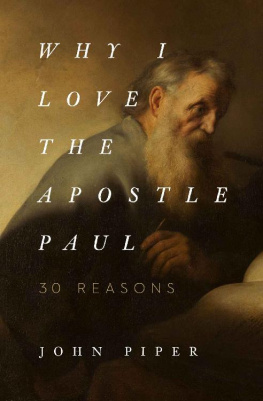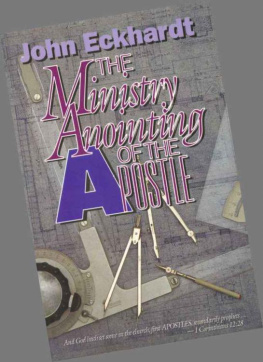St. John Bosco - Forty Dreams of St. John Bosco: The Apostle of Youth
Here you can read online St. John Bosco - Forty Dreams of St. John Bosco: The Apostle of Youth full text of the book (entire story) in english for free. Download pdf and epub, get meaning, cover and reviews about this ebook. year: 2009, publisher: TAN Books, genre: Detective and thriller. Description of the work, (preface) as well as reviews are available. Best literature library LitArk.com created for fans of good reading and offers a wide selection of genres:
Romance novel
Science fiction
Adventure
Detective
Science
History
Home and family
Prose
Art
Politics
Computer
Non-fiction
Religion
Business
Children
Humor
Choose a favorite category and find really read worthwhile books. Enjoy immersion in the world of imagination, feel the emotions of the characters or learn something new for yourself, make an fascinating discovery.
- Book:Forty Dreams of St. John Bosco: The Apostle of Youth
- Author:
- Publisher:TAN Books
- Genre:
- Year:2009
- Rating:5 / 5
- Favourites:Add to favourites
- Your mark:
- 100
- 1
- 2
- 3
- 4
- 5
Forty Dreams of St. John Bosco: The Apostle of Youth: summary, description and annotation
We offer to read an annotation, description, summary or preface (depends on what the author of the book "Forty Dreams of St. John Bosco: The Apostle of Youth" wrote himself). If you haven't found the necessary information about the book — write in the comments, we will try to find it.
Forty Dreams of St. John Bosco: The Apostle of Youth — read online for free the complete book (whole text) full work
Below is the text of the book, divided by pages. System saving the place of the last page read, allows you to conveniently read the book "Forty Dreams of St. John Bosco: The Apostle of Youth" online for free, without having to search again every time where you left off. Put a bookmark, and you can go to the page where you finished reading at any time.
Font size:
Interval:
Bookmark:
FORTY DREAMS
OF
ST. JOHN BOSCO

St. John Bosco 18151888
Founder of the Salesian Order
The Apostle of Youth
FORTY DREAMS
OF
ST. JOHN BOSCO
THE APOSTLE OF YOUTH
From the Biographical Memoirs of
St. John Bosco
Compiled and Edited by
Fr. J. Bacchiarello, S.D.B.
But they that are learned shall shine as the brightness of the firmament; and they that instuct many to justice, as stars for all eternity. Daniel 12:3TAN Books
Charlotte, North Carolina
| Nihil Obstat: | E. Gutierrez, S.D.B. | |
| August 21, 1969 | ||
| Imprimatur: |  | Stephen Ferrando, S.D.B., D.D. |
| Bishop of Shillong, India | ||
| September 21, 1969 |
This book was previously published in approximately 1969, in India, and printed at the Salesian Institute of Graphic Arts, Madras.
Re-typeset and re-published by TAN Books and Publishers, Inc. in 1996 with permission of Most Rev. Joseph Aind, now Bishop of Dibrugarh (Assam), and by arrangement with Salesiana Publishers, New Rochelle, New York. Re-typeset again in 2007 by TAN.
The type in this book is the property of TAN Books and Publishers, Inc., and, except for brief selections, may not be reproduced without written permission from the Publisher.
Library of Congress Catalog Card No.: 96-61323
ISBN: 978-0-89555-597-7
Printed and bound in the United States of America.
Cover picture of St. John Bosco and Boys of the Oratory reproduced by permission of Fr. Aurelius Maschio, S.D.B.
TAN Books
Charlotte, North Carolina
1996
CONTENTS
F OR THE ENGLISH translation of the dreams selected from Volumes I-IX and XI we are deeply indebted to Very Rev. Father Diego Borgatello and his collaborators in the translation of the Biographical Memoirs from the Italian. The volumes are a real monument, more lasting than bronze, erected to our saintly Father, Don Bosco.
130 Main Street
New Rochelle, N.Y. 10801
Some of these dreams have been reprinted from pamphlets published by the Salesian House of Tirupattur (North Arcot); others are from Father Mottas books printed by Tang King Po School (Hong Kong); others are new translations. Don Boscos vision of St. Dominic Savio is copied from a translation by Rev. Father Terence OBrien, S.D.B. in his book Dominic Savio, Teenage Apostle , Part II: Appendix.
For greater details about Don Boscos dreams, consult the chapter on Dreams, Visions and Ecstasies in Fr. Cerias book Don Bosco with God .
Dear Readers,
This second edition of Dreams of Don Bosco comes to you ten years after the first edition, which went out of print seven years ago.
At the request of many friends, I have revised and enlarged this new volume by the addition of many more dreams of special interest and utility to you.
A word about the dreams of Don Bosco: God spoke to Don Bosco in dreams. Who would ignore dreaming of dreams which the prophet Joel counts among the gifts that were to gladden, by a generous effusion of the Holy Spirit, the latter days , that is, as St. Peter explains, the days of the Messias? ( Acts 2:17). Don Boscos hearers gathered more than 150 dreams.
Some of Don Boscos dreams are prophetic, others are pedagogical, and some are parables. Some concern the Church, some the nations, others the Salesian Congregation, the missions, the Oratory (the first Salesian institution), etc.
Most of Don Boscos dreams are certainly supernatural events. Here are some proofs:
1. Sometimes he said that it was a dream in which one can know what one does; can hear what is said, can ask and answer questions. This does not happen in ordinary natural dreams.
2. He usually had a guide and interpreter. Who was he? Sometimes Dominic Savio or Louis Colle or an Angel, or St. Francis de Sales, or someone else. Their explanations are always precise and instructive. This does not happen in usual dreams.
3. Often he saw the secret things of conscience, and the test proved it always to be true; the foreseen future events (including deaths) did actually occur. This Don Bosco considered an extraordinary grace granted for the benefit of all the children of the Oratory .
4. Don Bosco used to narrate his dreams with a very great spirit of humility, thinking only of the spiritual benefit of his hearers. The good effects were evident: especially a greater horror for sin, better Confessions, General Confessions, more frequent Communions. It was, as he sometimes put it, The Devils Bankruptcy .
5. In natural dreams there is no logical order. All the opposite happens in the dreams of Don Bosco. Images and words are so well connected that one seems to hear things seen with open eyes.
6. Don Boscos dreams contained clear and exact revelation of events to come. As many prophecies as he had made of all kinds of things came about before or after his death. Innumerable examples can be read in the Biographical Memoirs (twenty large volumes).
7. On the 17th of February, 1871, Don Bosco candidly told some Salesians that these things are certainly singular and must be spoken of only among ourselves ( in the Salesian House ) , because if they were told to anyone outside, these people would certainly dub them as fables. But we have always this as our norm that, when something turns out to the good of our souls, it certainly comes from God, not from Satan .
In the 11th volume of the Biographical Memoirs , page 239, we read: Don Boscos dreams had become like a domestic institution at the Oratory. The expectation of new dreams was ever present. News of another dream aroused anticipation among young and old alike: its narration was eagerly listened to; its salutary effects were not long in coming.
May the reading of the following selection of dreams bring even now similar benefits.
God be with you.
F R . J OSEPH B ACCHIARELLO , S.D.B.S AVIO J UNIORATE
M AWLAI , S HILLONG 793008


THE FIRST DREAM
( Biographical Memoirs , Vol. I, page 94)
J OHN BOSCO, born in 1815, passed his earliest years in the happy liberty of the fields of Becchi, a small village in Piedmont, Italy. As a little shepherd boy, he would play with his young companions, drawing them away from evil and leading them on to virtue.
In 1823 he wanted to go to school in the town of Castelnuovo, a few miles away; but his ignorant twentyyear-old stepbrother prevented him, because he wanted hands to work in the fields and vineyard.
But during the winter of 1824-1825, when in Piedmont there is no work in the snowy fields, John Boscos mother sent him to school in a nearby village. There a priest of great piety taught him to read and write, and above all taught him his catechism and prepared him for his first Confession. Under the guidance of this priest, the young John Bosco learned the means necessary for preserving Gods grace in the soul by prayer and mortification.
Once able to read, John would often be seen with a book in hand, even while watching the animals in their pasture. On one occasion, some other shepherd boys wanted John to join their games, but he refused and they beat him. He might have paid them back. But forgiveness was his revenge. He told them: I cannot play, because I must study; I want to become a priest.
Next pageFont size:
Interval:
Bookmark:
Similar books «Forty Dreams of St. John Bosco: The Apostle of Youth»
Look at similar books to Forty Dreams of St. John Bosco: The Apostle of Youth. We have selected literature similar in name and meaning in the hope of providing readers with more options to find new, interesting, not yet read works.
Discussion, reviews of the book Forty Dreams of St. John Bosco: The Apostle of Youth and just readers' own opinions. Leave your comments, write what you think about the work, its meaning or the main characters. Specify what exactly you liked and what you didn't like, and why you think so.

